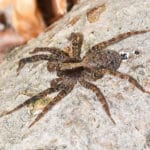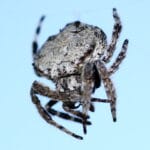Giant Spiders, Silken Parachutes, and Your Backyard
Joro spiders, those large, vibrant spiders native to East Asia, have been spotted drifting through the air on silken parachutes, captivating and concerning onlookers across the United States. This fascinating yet unsettling phenomenon, known as “ballooning,” isn’t unique to Joro spiders, but their size and the distances they cover have thrust them into the spotlight. So, what exactly is ballooning, which spiders engage in it, and should you be worried about a potential Joro invasion? Let’s delve into the world of these parachuting arachnids to find out.
Unmasking Spider Ballooning: A High-Flying Adventure
Imagine this: a tiny spider, perched precariously on a leaf, senses a gentle breeze. It raises its abdomen and releases a cascade of fine silk threads, catching the wind like miniature sails. These silken threads, acting as a natural parachute, whisk the spider into the air, carrying it away on a journey that could span incredible distances. This, in essence, is spider ballooning.
But why resort to such an extraordinary mode of travel? For spiders, especially smaller species and newly hatched spiderlings, ballooning offers a vital survival tactic. It allows them to:
- Disperse and Conquer: Escape from overcrowded habitats and colonize new territories, ensuring the survival and spread of their species.
- Seek and Find Mates: Travel vast distances to encounter potential mates, promoting genetic diversity within their populations.
- Evade Predators and Rivals: Outmaneuver ground-dwelling predators and avoid competition for resources with other spider populations.
While the image of countless spiders sailing through the air might seem like something out of a science fiction film, it’s a testament to the ingenuity of nature and the incredible adaptability of these eight-legged creatures.
Beyond the Joro: Meet the Arachnid Aeronauts
While the Joro spider’s ballooning feats have garnered significant attention, they’re far from the only species engaging in this aerial dance. A diverse array of spiders, from the diminutive to the surprisingly large, have adopted this method of dispersal, each with its own unique story to tell. Here are a few notable examples:
- Golden Silk Orb-Weavers: Close relatives of the Joro spider, these striking arachnids, known for their large, golden webs, are also adept balloonists. Native to the Americas, they haven’t exhibited the same rapid range expansion as their Joro cousins, but their ballooning capabilities are no less impressive.
- Crab Spiders: These stealthy hunters, often found camouflaged on flowers, waiting to ambush unsuspecting pollinators, are surprisingly adept at aerial travel. Their ballooning adventures, however, are typically reserved for their youth, aiding in their dispersal from their birthplace.
- Wolf Spiders: These agile ground hunters, known for their keen eyesight and swift movements, might seem unlikely candidates for ballooning. However, their spiderlings frequently take to the skies, utilizing silk threads to navigate their surroundings and seek out new hunting grounds.
- Tarantulas: Even these giants of the spider world, often feared for their size and potent venom, engage in ballooning, albeit primarily as spiderlings. Their forays into the air, while brief, are a testament to the widespread nature of this dispersal technique.
Joro Spiders: Separating Fact from Fiction
The arrival of the Joro spider in the United States has sparked a wave of intrigue and concern, fueled in part by sensationalized media coverage. Headlines proclaiming “Giant venomous flying spiders… heading to New York area” have only amplified public anxiety. Let’s dissect these claims and separate fact from fiction:
Fact: Joro spiders are venomous, as are most spider species. Their venom, however, is primarily designed to subdue insect prey and poses minimal threat to humans.
Fiction: Joro spiders are not aggressive and are far more likely to flee than fight when confronted. Their bites are rare and usually occur only if they feel threatened or are handled roughly.
Fact: Joro spiders have spread rapidly throughout the southeastern United States, raising concerns about their potential impact on native ecosystems.
Fiction: While their long-term effects are still being studied, Joro spiders are not inherently “bad” for the environment. They might even offer benefits, such as controlling populations of nuisance insects like mosquitoes and stink bugs.
The Science of Ballooning: A Closer Look
The mechanics of spider ballooning are surprisingly complex, involving a delicate interplay of physics, aerodynamics, and sensory perception. Here’s a glimpse into the science behind this extraordinary phenomenon:
Silk Release: Spiders possess specialized silk-producing organs called spinnerets, located at the rear of their abdomen. When preparing for flight, they release strands of silk, carefully adjusting the length and thickness to optimize their aerial ascent.
Wind Catching: These silken threads act as natural sails, catching even the slightest breeze. The spider, sensing the wind direction, adjusts its body position and the arrangement of its silk to control its trajectory.
Electrostatic Forces: Recent research suggests that electrostatic forces might also play a role in spider ballooning. The Earth’s electric field, generated by thunderstorms and other atmospheric phenomena, can interact with the negatively charged silk threads, providing an additional lift force.
Sensory Navigation: Spiders lack wings and traditional navigational systems, so how do they steer? While the exact mechanisms are still being unraveled, it’s believed they use a combination of sensory cues, such as wind direction, air pressure changes, and even the Earth’s magnetic field, to guide their aerial journeys.
Uncertain Landings: Perhaps the most unpredictable aspect of ballooning is the landing. Spiders have little control over where they touch down, relying on chance encounters with suitable habitats. This element of randomness contributes to their widespread dispersal and colonization of new environments.
Unveiling the Mysteries of Joro Spider Ballooning
While general ballooning principles apply, research suggests that Joro spiders exhibit unique characteristics that contribute to their successful spread:
Hatchling Balloonists: Like many spider species, Joro spiderlings are the most frequent balloonists. Emerging en masse in spring, they take to the skies, utilizing wind currents to disperse away from their birthplace and avoid competition with their siblings.
Elevated Launch Points: Joro spiders often select higher launch points, such as trees, tall structures, or even vehicles, to maximize their exposure to wind currents and increase their potential travel distance.
Impressive Range: While exact distances vary depending on wind conditions and other factors, Joro spiders have been documented to travel up to 100 miles via ballooning, far exceeding the range of many other ballooning spiders.
Cold Tolerance: Studies suggest that Joro spiders possess a surprising tolerance to cold temperatures, even surviving freezing conditions while airborne. This adaptability might explain their rapid spread into regions with colder climates, challenging previous assumptions about their range limitations.
Joro Spiders and the Future: What Lies Ahead?
The Joro spider’s arrival in the United States has presented scientists with a unique opportunity to study the ecological impacts of an invasive species in real-time. While their long-term effects remain uncertain, ongoing research seeks to answer critical questions about their potential impact:
Competition with Native Species: Will Joro spiders outcompete native spider species for food and resources, potentially disrupting established ecosystems?
Predation and Prey Dynamics: How will their presence impact local insect populations, and will they become a food source for native predators, such as birds and reptiles?
Spread and Range Expansion: Given their ballooning capabilities and cold tolerance, how far will they spread, and what factors might limit their distribution?
The answers to these questions will have significant implications for our understanding of invasive species, ecological balance, and the intricate web of life that connects us all.
People’s Statements
- “According to a previous publication from UGA researchers, the Joro spider travels by ballooning, or parachuting, with their webs. An orb weaver species, they let “wind carry them,” where they go.” (Source: wfla.com)
- “Researchers say this allows these critters to travel to different locations miles away, make new colonies, multiply, then move again to other locations.” (Source: nj.com)
Coexisting with Parachuting Spiders
The Joro spider, with its striking appearance and impressive ballooning feats, serves as a reminder of the awe-inspiring diversity and adaptability of the natural world. While their presence might spark initial fear, understanding their behavior, ecological role, and the science behind their extraordinary journeys can foster appreciation and informed coexistence. As we continue to unravel the mysteries of Joro spiders and their ballooning prowess, we gain a deeper understanding of the interconnectedness of life on Earth and the importance of approaching the natural world with curiosity and respect.
- Amazing March Fun Facts: Unveiling History & Celebrations - April 15, 2025
- Master how to write height: A complete guide - April 15, 2025
- How High Are Your Standards Test: Find Your Perfect Match Now - April 15, 2025
















